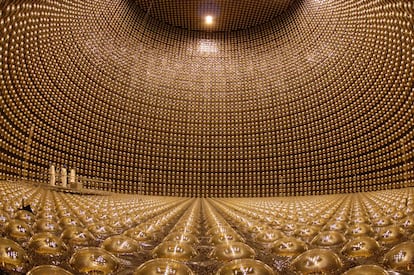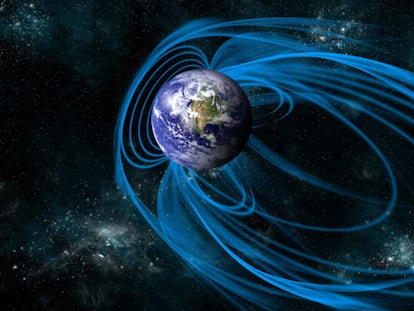Do neutrinos move in straight lines?
Moving along geodesic lines, these particles do not interact with electromagnetic fields, which could cause them to deviate from their path

In answer to the question, yes, we could say that neutrinos travel in a straight line from the source in which they were produced. In fact, it is what makes them attractive to astrophysicists. The fact that their path from the place where they were generated does not deviate gives us information about where the source is located. If we are able to detect the neutrinos produced during a supernova explosion, we could know where that supernova occurred. This would be the short answer, but a more detailed explanation is needed because it is not that simple.
Neutrinos are fundamental particles that are very, very small and have no electrical charge. In fact, they are so small that for a time it was thought that they had no mass. This means that they have a minimal interaction with matter. Nuclear reactions inside stars produce different particles such as photons and neutrinos. Unlike photons — which, although they have no charge or mass, behave as if they did when they interact with matter — escaping neutrinos follow a rectilinear path without interacting with anything.
That happens inside a star, but what happens in the universe? In the cosmos, neutrinos move in the same way. As they have no charge, they do not interact with electromagnetic fields that could divert them from their path, and it is also very unlikely that they will interact with matter due to their low mass. That is why we say that neutrinos travel in straight lines, because they do not interact with any other matter in the universe. This is something that happens with other particles, such as cosmic rays, which interact with electromagnetic fields or photons.
Neutrinos could interact with matter through the force of gravity. However, although they have mass, it is so small that even in the event that one encounters a very massive object that significantly curves space-time, such as a supermassive black hole, the probability of interaction is practically negligible.
However, we must clarify that neutrinos move in a straight line because the space-time of the universe is not flat, but curved due to the matter it contains. Taking this curvature into account, neutrinos actually move along geodesic lines (which are the shortest path between two points on a given surface). It is something analogous to the trajectory of airplanes on the surface of the Earth: they do not fly in a straight line between Madrid and New York. Instead, they deviate towards the north when crossing the Atlantic Ocean due to the curvature of the Earth. Of course, if we limit ourselves to a small region of the universe without large masses, what is known as Minkowski space, the curvature is minimal and the geodesic line is the same as a rectilinear path.
To answer the question, then, I would say that neutrinos move along geodesic lines, which — in the absence of large masses such as supermassive black holes that significantly curve space-time — coincide with straight-line trajectories.
And it is precisely this straight-line movement of neutrinos that makes them so interesting for astronomy. That, and they are very fast particles. They are believed to travel at velocities very close to the speed of light. In fact, some studies argue that they could overtake light, although the results are highly disputed. Because they are so fast and there is nothing to deflect them, they reach Earth before the photons. And because of that, they are very important in detecting a supernova explosion. The people who do research with neutrino detectors — such as Super-Kamiokande, located in Japan and where I work — are prepared so that, in the event of a supernova explosion, scientists can put out an alert in a matter of seconds. It is only necessary to detect the neutrinos and tell the telescopes, in space and on Earth, where they should point their lens to observe the phenomenon from the beginning of the explosion.
Nataly Ospina Escobar is a researcher in the Department of Theoretical Physics of the Autonomous University of Madrid.
Sign up for our weekly newsletter to get more English-language news coverage from EL PAÍS USA Edition
Tu suscripción se está usando en otro dispositivo
¿Quieres añadir otro usuario a tu suscripción?
Si continúas leyendo en este dispositivo, no se podrá leer en el otro.
FlechaTu suscripción se está usando en otro dispositivo y solo puedes acceder a EL PAÍS desde un dispositivo a la vez.
Si quieres compartir tu cuenta, cambia tu suscripción a la modalidad Premium, así podrás añadir otro usuario. Cada uno accederá con su propia cuenta de email, lo que os permitirá personalizar vuestra experiencia en EL PAÍS.
¿Tienes una suscripción de empresa? Accede aquí para contratar más cuentas.
En el caso de no saber quién está usando tu cuenta, te recomendamos cambiar tu contraseña aquí.
Si decides continuar compartiendo tu cuenta, este mensaje se mostrará en tu dispositivo y en el de la otra persona que está usando tu cuenta de forma indefinida, afectando a tu experiencia de lectura. Puedes consultar aquí los términos y condiciones de la suscripción digital.
More information
Últimas noticias
From safe-haven investment to geostrategic weapon: Who owns the most gold and where are the bars kept?
Todd Green, head of the company that created ‘Candy Crush’: ‘Success for us is that players want to play for years’
Prices soar and Venezuela’s economy struggles under Trump’s pressure: ‘People are living day to day’
From Hungary’s Orbán to Chile’s Kast: How Trump helps turbo charge the far right
Most viewed
- Why we lost the habit of sleeping in two segments and how that changed our sense of time
- Charles Dubouloz, mountaineering star, retires at 36 with a farewell tour inspired by Walter Bonatti
- Venezuela faces its most tense Christmas yet
- CBS in crisis after pulling a report on Trump’s deportations to El Salvador (which later leaked online)
- Bukele clan fumes over investigation exposing their new wealth










































